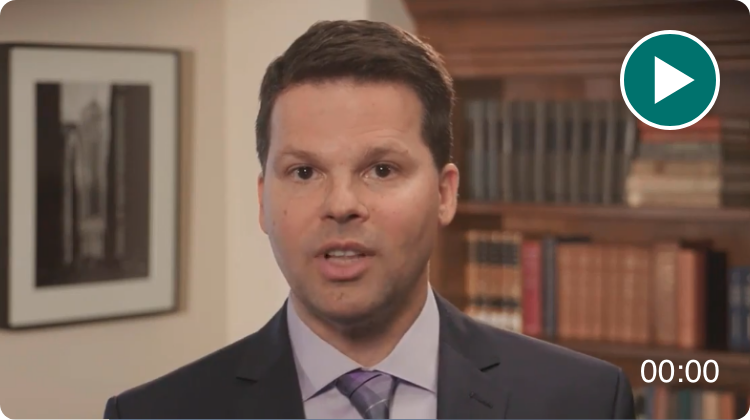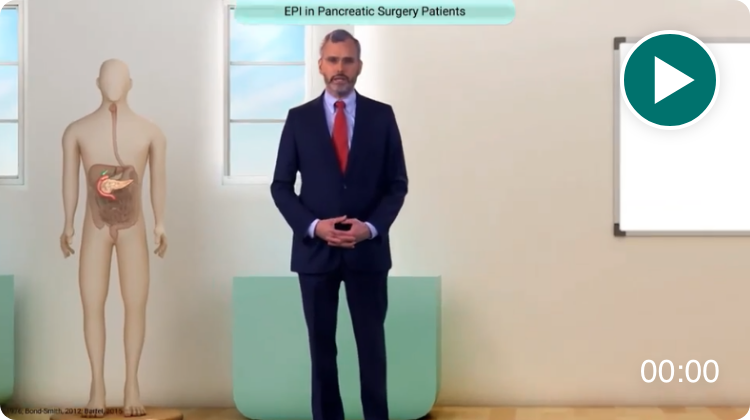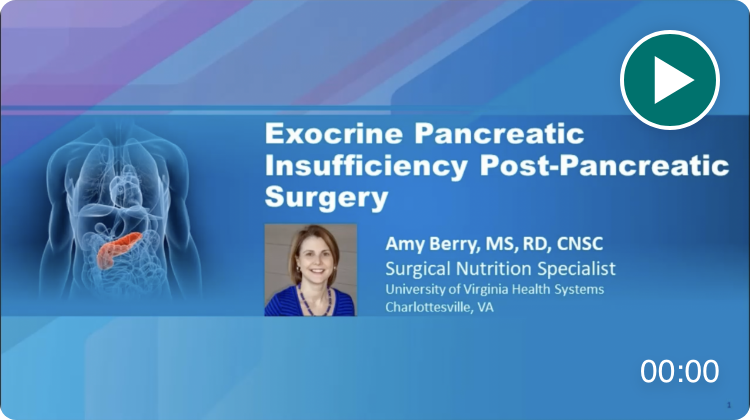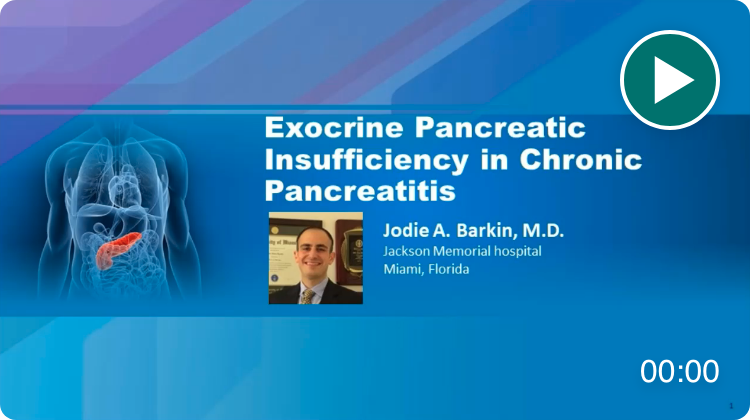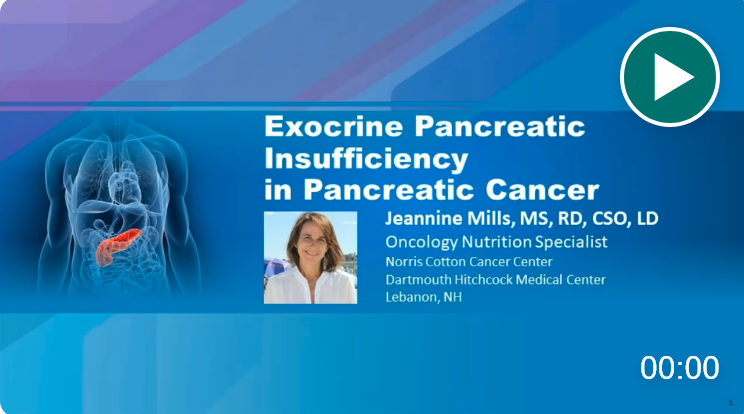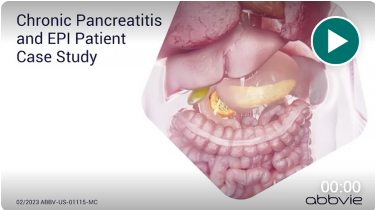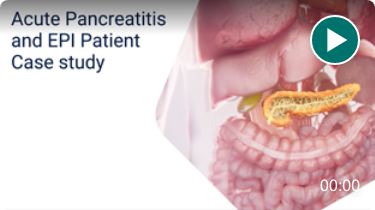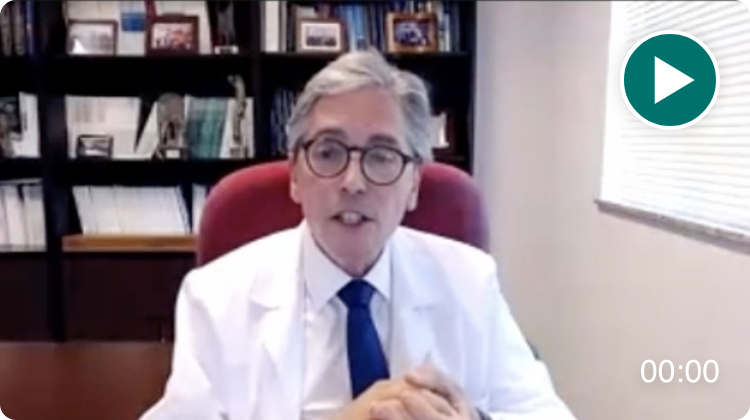
EPI Education
Take a deep dive into EPI and learn from experts in the field.
About EPI: EPI pathogenesis, symptoms, and diagnosis
Etiologies of EPI: Recognize EPI and the barriers to diagnosis
Management of EPI: Key information for managing EPI
Case Studies: Experts present case-based narratives on EPI
Select one or more filters below to explore topic-specific resources.
Transcript
So, a 55-year-old gentleman comes into the hospital. He is complaining of abdominal pain, primarily in the epigastrium. So, the upper top part of the abdomen radiating to the back. He has a long history of alcohol abuse, a long history of smoking. Multiple hospitalizations for acute pancreatitis secondary to alcohol abuse over the last 15 years. And he notes that in about the last four months, there's 15 pounds of weight loss. Now complaining of bloating, diarrhea, and those foul-smelling stools that we talked about. And talking to him a little bit more, he notes that he tripped and fell down a couple of stairs a couple of months back and had a hip fracture. A little bit odd in a 55-year-old.
A CAT scan performed for further evaluation of the abdominal pain reveals dilation and beading in the main pancreatic duct. Pancreatic parenchymal atrophy, calcifications in the parenchyma, and importantly, no evidence of malignancy. These are all findings that we would see in a patient with chronic pancreatitis on imaging.
Fecal elastase testing is performed and is low. Again, consistent with chronic pancreatitis. And after the patient’s diagnosed, some additional workup is performed. First with a vitamin D level that's noted to be low. A DEXA scan showing osteoporosis. And finally, the patient is screened for diabetes and has both abnormal glucose tolerance testing and also an elevated hemoglobin A1C.
The next question we have to ask ourselves is, well, what's chronic pancreatitis? So, I want you to think of chronic pancreatitis as cirrhosis of the pancreas. Okay, we all know what cirrhosis is. So, what's chronic pancreatitis? Well, it's irreversible. It starts off with inflammation, progresses to fibrosis, and then progresses to scarring. So, irreversible damage to both endocrine tissue resulting in glucose abnormalities such as diabetes and exocrine tissue resulting in malabsorption, maldigestion.
There are a variety of etiologies for chronic pancreatitis. The TIGAR-O classification is perhaps one of the most popular. Initially postulated by Dr. Whitcomb at the University of Pittsburgh. And just to highlight a few here, of the most common, we look at alcohol and tobacco in the world of toxins. Idiopathic, unfortunately in some patients, we are not able to identify a cause. Genetics, so this is where cystic fibrosis, Alpha-1 Antitrypsin deficiency, et cetera, comes into play. Autoimmune chronic pancreatitis. Patients that have recurrent, severe acute pancreatitis.
So, the patient who comes in with an episode of alcoholic pancreatitis every year for about 15 years may go on to develop chronic pancreatitis. And also, obstructive etiologies. Congenital such as pancreatic divisum, or acquired, such as neoplastic processes.
In chronic pancreatitis, these patients, for the most part, will develop exocrine insufficiency, and this is based on a destruction of the parenchyma, as well as an obstruction of that duct.
So, those strictures and stones mean that the functional tissue that’s there may have a difficult time in secreting both enzymes and bicarbonate and making it from the parenchyma through the ducts and into the duodenal lumen.
We know that the prevalence of exocrine insufficiency increases with duration of disease process. That severity increases over time. And after about 12 years, nearly half of our patients will suffer, unfortunately, from exocrine insufficiency. The nutrition deficiencies in these patients are really multi-factorial.
So, in our patients that are alcoholics, we often know that they may substitute alcohol for food consumption, have poor dietary habits to begin with, and that may compound nutrition deficiencies at baseline.
Diabetes adds an entirely new set of compounding factors. At the point when even if they have a normal dietary intake, they're not able to digest and absorb their food secondary to excrete insufficiency. This again compounds their problems.
We know that chronic pancreatitis, remember, is a pro-inflammatory state. It starts off with inflammation before fibrosis and scarring which is a catabolic state. So, there's increased metabolic activity.
And finally, the symptoms that they have as a result of their disease process may mean that patients either avoid eating to avoid postprandial pain or are not able to tolerate enough nutrition to maintain adequately based on symptoms either of pain, nausea, or vomiting. This leads to fat-soluble vitamin deficiencies. We know that vitamin A and E deficiencies may often be subclinical, but happen in up to a quarter of our patients, leading to vision problems and sometimes brittle hair, skin, and nails. Vitamin K deficiencies happen in up to about half of our patients. And while clinically overt deficiency may be rare, i.e. patients are not developing large coagulopathies, we may see easy bruising and bleeding as a subtle finding in these patients.
And finally, osteopathy is perhaps most common in nearly 9 in 10 out of our patients, with fractures being an increasing problem of morbidity in this group. In the American population as a whole, osteopenia and osteoporosis are very common. But in our population with chronic pancreatitis, these effects are magnified. With nearly two-thirds of our patients suffering from these debilitating disorders. This increased risk of fractures further compounds their morbidity in this disease process. And this is truly multi-factorial, so it's not solely based on vitamin D deficiency from exocrine and pancreatic insufficiency, but rather from poor dietary factors such as alcohol and smoking intake, as well as the chronic inflammatory cascade that underlies their disease process.
Diabetics have particularly difficult problems when they have coexisting exocrine sufficiency because for the most part, we know that exocrine insufficiency will happen before endocrine insufficiency. And there's an increased risk with longer duration of disease. Prior pancreatectomy, so loss of potential parenchyma. And those same pro-inflammatory mediators that destroy exocrine tissue also destroy endocrine tissue. And this pancreatogenic diabetes, type 3c, is particularly difficult because there may be high peripheral insulin resistance. And yet these patients, conversely, are also prone to hypoglycemic episodes making their management particularly challenging.
But I want you to remember one thing and please take this out of tonight's talk. If you're seeing patients, in your clinics with new onset, or worsening diabetes in the setting of chronic pancreatitis, they need to be worked up for malignancy. Because a change or new onset of this may be a harbinger of things to come and early recognition may change outcomes.
So, how do we manage exocrine insufficiency? This is where pancreatic enzyme replacement therapy has the role. We administer full dose enzymes with meals, half dose with snacks, and I emphasize the "with," because this is not 30 minutes before meals. This is not a half-hour after meals. This is taking it with meals because, if not, we create the exact same type of asynchrony where we're not having mixing of enzyme and food the same way that the patients have gastric bypass where you're not having movement of gastric chyme and food contents from the stomach into the duodenum where they would normally have mixing.
And there's no one-size-fits-all strategy here. We have to individualize the dosage of enzymes based on clinical symptoms, the degree of steatorrhea that these patients have, as well as their specific dietary requirements. And oftentimes, the dosages have to be adjusted over time to appropriately meet their needs. Assessing their nutrition is really multidisciplinary. This is where nutritionists, dietitians, gastroenterologists, endocrinologists, primary care physicians, and pancreatic surgeons have to work together. We know that there are a variety of clinical symptoms, as we've discussed from nausea and vomiting, to pain, diarrhea, and steatorrhea, often resulting in failure to thrive, malnutrition, and weight loss.
It's important to take a careful dietary history, monitor these patients’ weights. Remember that the pancreas is both an endocrine organ and an exocrine organ. And how do we address the challenges of both diabetes and maldigestion? Recognize that there's going to be fat-soluble vitamin deficiencies. This will have problems with bone health over time. And then finally, target modifiable risk factors in our patients, such as alcohol and smoking cessation and increasing physical activity.
So, back to our patient, our patient was referred to the nutritionist, the endocrinologist, was counseled extensively in alcohol and smoking cessation. He was started on enzyme replacement therapy with meals and snacks. Three months later, the diarrhea and steatorrhea is somewhat improving. Not perfect, but improving. Weight is slowly starting to rise. And at that point, the decision is again made to individualize enzyme replacement therapy dosage by increasing it. And at the sixth-month follow-up visit, the patient's bloating and diarrhea and stools are normalizing. Weight and nutritional status continue to improve. And enzyme replacement therapy is continued.
A few take-home points for tonight. Remember that chronic pancreatitis is irreversible. This is the cirrhosis of the pancreas. There is progressive inflammation leading to a cascade of fibrosis and scarring that affects both endocrine and exocrine pancreatic tissue. We often see exocrine insufficiency in patients with chronic pancreatitis. We have to have a high level of suspicion for patients with chronic pancreatitis when they have risk factors such as recurrent episodes of pancreatitis, pain, maldigestion, et cetera. And we have to intervene early to evaluate and correct those nutritional sequelae to help improve patient quality of life and long-term outcomes. And the way that we do that in terms of enzyme replacement therapy is key to individualize based on each patient and their needs.
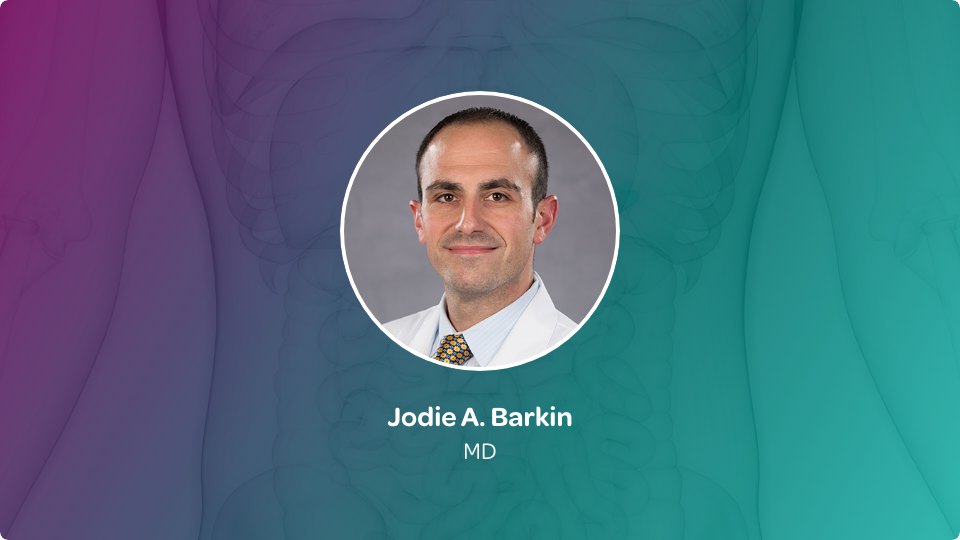
EPI in Chronic Pancreatitis: An In-depth Case Study
Learn how malabsorption due to EPI can cause problems in chronic pancreatitis patients.

Take an immersive journey into the physiology of the exocrine pancreas and the pathophysiology of EPI.


